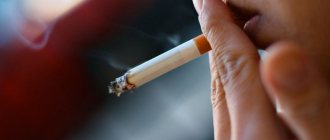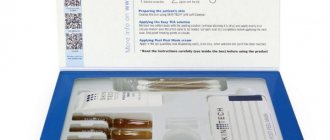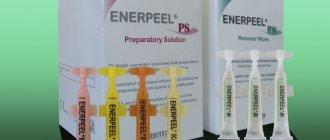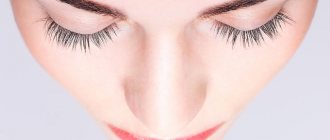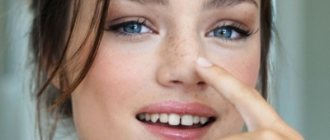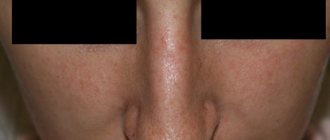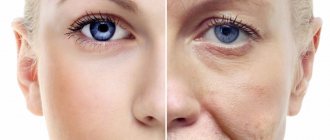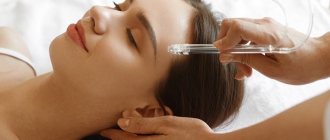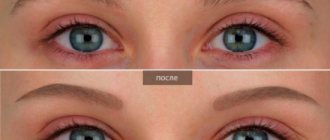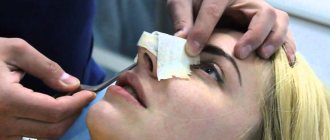Any surgical intervention, including rhinoplasty (open or closed rhinoplasty), has a certain percentage of risks and side effects.
The reasons that influence the occurrence of such reactions are different. These include:
- Individual characteristics of the body (tendency to bleeding, dense superficial vascular network, tendency to allergies, edema, excessive formation of connective tissue at the site of the scar, etc.);
- Practical experience of the surgeon and the selected surgical technique;
- Concomitant diseases (arterial hypertension, hypovitaminosis, etc.)
Causes and areas of formation of nasal swelling after rhinoplasty
One of the expected side effects that is unpleasant for the patient is swelling and bruising after rhinoplasty. This is due to the fact that the skin and underlying tissues in the area of the nose and adjacent tissues are densely intertwined with a network of blood vessels, so during surgery they are injured, the tissues of the nose are damaged, which causes a natural inflammatory reaction and minor bleeding. This leads to bruising (tissues become saturated with blood flowing from damaged vessels) and swelling (intercellular fluid accumulates in the area of damaged tissues).
The most commonly affected tissues and vessels are in the area of the back and wings of the nose, as well as around it and the tissue under the eyes (they are connected by a common blood network). Therefore, it is in these areas that swelling and bruising occur. Although such effects are expected and predictable, patients still have questions about when the swelling will go away after rhinoplasty, whether it is necessary to take any medications or perform various manipulations.
Consequences that are visible to the naked eye
Aesthetic complications:
- Curvature of the back of the nose.
- Asymmetry. To understand, you need to divide the nose into two parts and see if the parts are the same. You may end up with different nostrils.
- A beaked nose deformity is when the nose is very full above the tip, and the tip itself is disproportionate to the rest of the part and is often curved down.
- Drooping /excessively upturned nasal tip.
- Shortened tip of the nose.
- Saddle deformity. The bridge of the nose sags approximately in the middle. With pronounced deformation, the angle of subsidence is significant, visible to the naked eye, and the tip of the nose protrudes noticeably. The skin at the site of deformation becomes mobile and folds without effort.
How long do bruises and swelling last after rhinoplasty?
The reactions of each organism vary greatly, so it is impossible to answer how long bruises and swelling of tissues last after rhinoplasty with an accuracy of up to a day. In most patients, they go away on their own as the tissue recovers. However, minor swelling and hardening of small areas of the nose can persist throughout the year, especially if an osteotomy was performed - removal of part of the bone skeleton with injury to the periosteum and cartilaginous part of the nose. Even if the procedure is carried out using the most modern methods using the latest equipment, when the size or shape of an organ changes, or the cartilage or bone structures are corrected, the tissue is damaged and swells during the operation.
There is a certain dynamics of the development and disappearance of edema after rhinoplasty by month.
Maximum swelling during nasal rhinoplasty usually lasts up to 2-3 weeks. They appear even during surgery due to mechanical trauma and the release of fluid from cells and vessels, and intensify during the first days. Changes in bruised tissue and severe swelling reach their peak by the end of the first week. Then they will gradually go away. Simultaneously with the swelling, bruises gradually disappear; they are most pronounced by 4-5 days, then slowly go away.
By 2-3 weeks, swelling subsides so much that a person can go to work and return to normal life, although tissue swelling may persist, especially inside the nasal turbinates. By this same period, bruises and hematomas completely disappear. It takes the longest for swelling of the periosteum to go away after rhinoplasty: by the end of 2-3 months, swelling remains in the area of the back of the nose and its tip.
From the 4th month until the end of the first year, the swelling becomes invisible to others, it can only be felt by the patient himself and is detected by the doctor during examination. Tissue swelling gradually disappears completely. If the swelling does not disappear within this period or increases, the tissues acquire an unnatural density or softness, you should immediately consult the doctor who performed the rhinoplasty and determine how and how to remove the swelling after rhinoplasty. Your doctor may recommend a course of physical therapy or medication.
Causes of complications
Causes of complications:
- Choosing the wrong doctor. Little experience in performing operations increases the possibility of surgeon error.
- Ignoring the requirements of the attending physician. Failure to comply with the regimen, refusal to use medications, physical actions that can damage the nose - all this leads the patient to the need to undergo surgery again.
- Individual intolerance to the drugs used during surgery.
Rhinoplasty is not only a quick operation and recovery over several months, it is a long preparatory period, during which you need to select the desired shape and coordinate it with your doctor. This step should not be skipped, as the result may not be what the patient expected.
To get the best results from rhinoplasty, surgery is recommended after the age of 20.
If correction is necessary following the operation, it is prescribed after 6-12 months.It is during this period that the final result of primary rhinoplasty is visible.
Cosmetologist, dermatologist, trichologist
Kalinina Olga Alexandrovna
4 years of experience
If possible, you need to make an approximate model of the future nose - modern technologies allow this.
How to reduce swelling and bruising
At first, when the swelling is most pronounced, you just need to be patient. The doctor will recommend medications and additional procedures that help reduce swelling for a few hours. But while the tissues are healing, they will not go away completely.
To relieve swelling after rhinoplasty, there are a number of recommendations that should be followed from the first days and at each stage.
Key recommendations in the first week of rehabilitation:
- swelling goes away faster with rest and sleep in a semi-sitting position;
- in the first week you should not massage or put pressure on your face or use cosmetics;
- it is important to exclude elevated temperatures (beach, saunas, hot baths);
- sharply limit any physical activity, especially with sharp tilts of the head or body forward and down.
In the second or third week of recovery, it is important to:
- Avoid sleeping on your side or stomach, especially with your face in the pillow;
- avoid sudden displacement of the skin and underlying tissues on the face (massage, overload);
- avoid exposing swollen areas to heat;
- limit physical activity to household chores only.
The doctor may recommend ointments, gels with decongestant, anti-inflammatory components.
During the second or third month after surgery, swelling remains in the area of the back or tip; for a speedy recovery, doctors recommend giving up smoking and drinking alcohol, and putting pressure on the damaged tissue with glasses, fingers, and various objects. You should also avoid prolonged tilting of your head forward and down.
If by the 4th month the tissues are still swollen, a course of physiotherapy prescribed by your doctor will help relieve nasal swelling after rhinoplasty.
Rehabilitation in the early postoperative period
After rhinoplasty is completed, the patient begins to wake up from anesthesia. The sleep effect is most often used, so the complexity of this part depends on the correct choice and calculation of medications. To minimize discomfort after surgery, the patient is prescribed premedication.
In winter, in the northern regions of the country, you should avoid long walks on the streets.
The reason is that the nose is less well supplied with oxygen and warm air from the lungs, while people often do not feel that their skin is freezing.The general recommendation for all cases is to watch your hands and not touch your nose with them.
Cosmetologist, dermatologist, trichologist
Kalinina Olga Alexandrovna
4 years of experience
At this point in rehabilitation, a number of symptoms are observed:
- Dizziness
. - Nausea.
- Weakness.
- Constant desire to sleep.
Rhinoseptoplasty
Rhinoseptoplasty is a type of surgical intervention, the essence of which is to correct a deviated nasal septum, as well as change the shape and appearance of the nose.
The above symptoms will go away immediately after the drugs wear off. To avoid irritation and inflammation and to prevent high fever, a number of antibiotics are usually taken after rhinoplasty.
The course of treatment is most often individual. In some cases, the patient also takes painkillers.
Fixation of the nose after surgery
Recovery after rhinoplasty is a difficult period, as you need to constantly monitor the condition of your nose. The slightest damage can cause serious damage to regenerating tissues.
To protect the nose during the recovery period, special fixing devices are used, the main ones of which are:
- Plaster bandages (splint).
- Thermoplastic.
Thermoplastic is more popular, since it does not need to be constantly adjusted to the decreasing swelling. You should also use special nose plugs during the recovery period.
They absorb tumor secretions and make recovery less uncomfortable. Nowadays, hemostats or silicone devices are used.
They contain an air passage so that the airway is not blocked during recovery. Also, they do not remain on the mucous membrane, which further increases the patient’s comfort.
These clamps are removed within two weeks after surgery.
If swelling does not go away for a long time
Sometimes there are situations when changes in tissues remain longer than usual or increase. In these cases, you need to consult a doctor. The time it takes for swelling to subside after rhinoplasty depends on age, tissue characteristics and additional factors that need to be taken into account. During the examination, the doctor will make sure that there are no complications, and swelling and bruising are consequences of the operation, and not additional problems after it. To speed up the healing process, the doctor may recommend local medications (gels, creams) or a course of procedures that improve fluid outflow and microcirculation.
After which the help of a doctor is required
Bruises usually go away very quickly, but some complications should be dealt with by a high-level specialist, preferably an experienced surgeon. His help should consist not only in placing cotton swabs and prescribing tablets, but also in repeated consultations and, if necessary, surgical intervention.
List of main complications after which reoperation is inevitable:
- Abscess.
- atrophy .
- dysfunction .
- Intracranial complications after rhinoplasty.
- Perforation of the septum.
Does callus resolve or need to be removed?
Bone formation occurs over a long period of time. Repeated surgery is quite rarely prescribed. It is carried out in the following cases:
- with hypergrowth of fibers;
- for functional disorders of the nasal passages;
- at elevated temperatures;
- when elements of inflammation appear, for example, redness on the bridge of the nose.
At the first sign of a defect, you should consult a doctor. The problem can be identified by the following symptoms:
- the formation of a small hump on the bridge of the nose;
- change in proportions, asymmetry;
- swelling.
The defect can actually resolve if certain measures are taken in the early stages, in particular, taking medications and undergoing physiotherapeutic procedures.
It is very important to follow a postoperative regimen that will help prevent the development of bone tissue at the site of injury. You must visit the surgeon at least five times within one year. This allows you to record the result obtained.
About callus after rhinoplasty, watch this video:
Prohibitions
It may seem that the recovery will be very long and difficult: an abundance of bruises, plaster casts, difficulty breathing. In fact, this procedure is one of the most painless corrections. Unpleasant sensations pass very quickly, but every person should be aware that there are a number of contraindications for the rehabilitation period after rhinoplasty.
Basic prohibitions during the recovery period
- Sleeping in any position other than face up is prohibited
- Wearing glasses due to the risk of nasal deformation. For people with poor vision, it is recommended to wear lenses for three months after surgery.
- No heavy loads.
- Do not take a hot bath or shower.
- Avoid any kind of sunbathing for one to two months.
- No pool for two months
- You should try to limit yourself from the possibility of catching a cold or any similar disease that irritates and affects the mucous membrane.
- Any stressful situations are prohibited.
How to reduce your nose with potatoes
A large nose, or as it is also called, a potato nose, is not a pathological condition, but a natural defect associated with the individual structure of the cartilage and bones of this organ.
It is a very common fear that rhinoplasty surgery may leave permanent scars on the face. This is wrong. In both open and closed surgery, the skin on the main part of the face and nose is not subjected to any kind of damage.
The only part of the skin where any traces will remain is the septum between the nostrils, but even on it, with proper care, there will be no trace of surgical intervention.
Medicines after
Post-rhinoplasty medications such as Lyoton, Dimexide and Troxivazin will help speed up the disappearance of edema during the recovery process. Medicines must be prescribed by your doctor.
Sports after rhinoplasty
Many physically active patients want to continue exercising after rhinoplasty.
In order to get rid of swollen cartilage and swelling, it is recommended to massage the nose. This series of exercises is available for you to do independently:
- Massaging the tip of the nose with two fingers.
- Massaging the bridge of the nose with two fingers.
Procedures should be performed several times a day, thirty seconds each.
Final result, before and after photos of women
Operating plastic surgery
The final result after surgical rhinoplasty appears a year or a year and a half after surgery. However, this is only possible if you follow your doctor's recommendations.
No surgery
The non-surgical rhinoplasty method shows results within 3 days after the procedure.
Despite the fact that it does not give a strong transformation, the effect lasts about two years.
Find more information about non-surgical rhinoplasty here.

